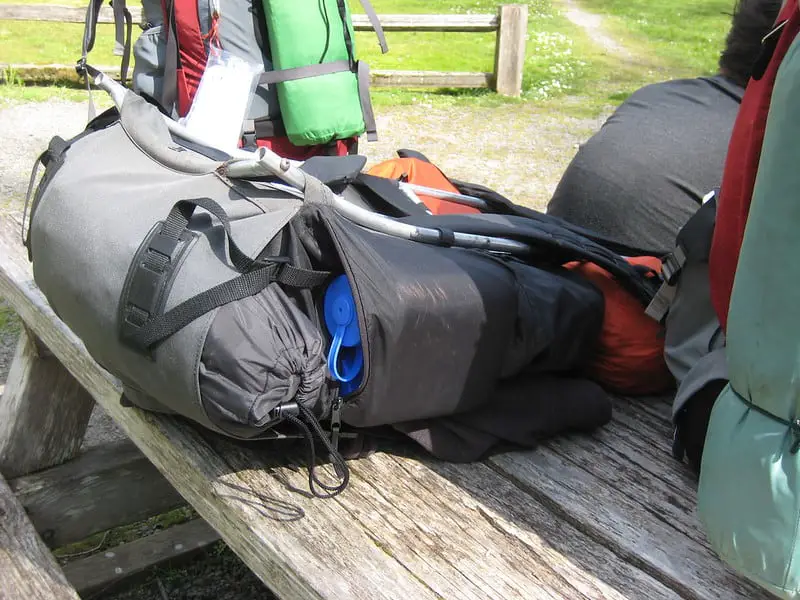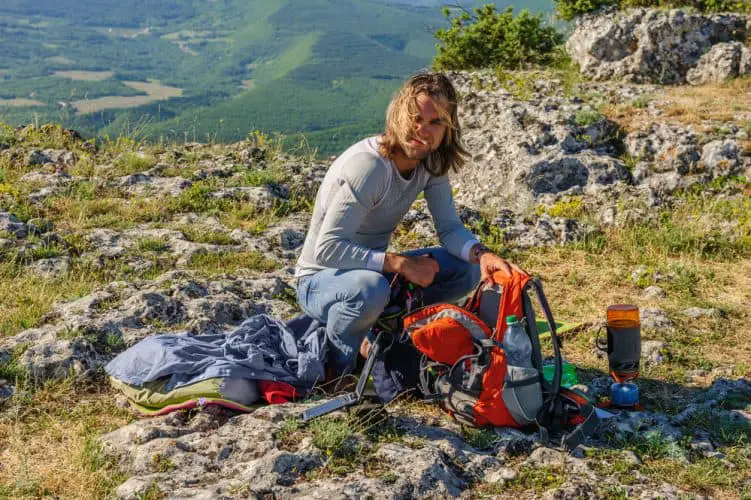How to Attach A Sleeping Bag To A Backpack? (See How)
According to nps.gov, a sleeping bag is one of the must-have items for a safe and comfortable camping trip.
We’ve all seen images of people with stuff strapped all over the outside of their pack as well as images of thru-hikers where their pack is unadorned with external accoutrements.
That’s a fancy way of saying their packs look clean like an ad in a catalog.
But how to attach a sleeping bag to a backpack? What way is best, and why do different people do it differently?
In this article, we are going to go over how to pack your sleeping bag and why you might carry it in or out of your pack.
And a quick spoiler – always put your gear in your pack if you have the room.
Let’s begin.
How to attach a sleeping bag to a backpack?
You have two main ways to attach a sleeping bag to your backpack. The first is actually to put your sleeping bag inside your backpack.
The second way is to strap your sleeping bag on the exterior of the pack using the compression straps and the backpack loops.
Once your pack is fully loaded, you just put your bag on top of your pack under the lid. To do that, it's enough to tighten it up with the top straps.
Most backpacks have external lash points (backpack loops) hanging down the back panel that can allow you to attach gear to the outside. Heck, some packs even have tons of gear loops and daisy chains on the shoulder harness.
On some modern packs, those compression straps are even called sleeping bag straps or sleeping pad straps. So, yes, you can attach sleeping pads too.
In the rare occasion where you don't have straps, you can use either a rope or bungee cords.

Attaching the sleeping bag on the exterior of a hiking pack is often the preferred way. But is it the best?
By feeding the compression straps near the back panel through these points and around your sleeping bag in its stuff stack, you can cinch the sleeping bag tightly down.
Compression strap systems are great because often you use them to stabilize your bottle that you've put in the side water bottle holder. They come in handy because we always want proper weight distribution and stable load.
In most cases, you just connect the pack loops to the stuffing sack straps on the carrying bag of your sleeping bag. Nowadays, most sleeping bag sacks have stuffing sack straps on the carrying bag.
Most packs also have compression buckles on the sides of the back panel. The compression buckles are used to tighten up the load.
You can use the compression buckles to attach your sleeping bag in a way that the weight is distributed evenly.
So, how to use compression buckles for that? It's easy. Just open the compression buckles, put your sleeping bag and then close the compression buckles.
Sea to Summit Accessory Straps with Hook Release are my favorite, as they can be released without being completely unthreaded.
The bucket hardware is made of aluminum instead of plastic, so they are more durable as well.
If you have to attach a sleeping bag to the outside, my first choice would always be on top if your pack will handle this. Under the top lid is one option or use the lash points that are on the top of the pack if it has them.
Second choice would be on the back of the pack. The lash points tend to be vertically oriented, so your straps will have a twist in them. It will still work.
Use two straps around the sleeping bag at the same level and a third strap in the middle attached to a higher point on the pack to keep your sleeping bag from bouncing around.
Another way to achieve this is to run the strap through more than one of the lash points on the pack to widen the area of support.
As you may know, there are two general ways of carrying your sleeping bag – you can put your sleeping bag inside and on the exterior of your backpack.
For further clearance, let’s examine each way in more detail and see the major pros and cons of attaching sleeping bags inside and outside of your pack.
Stowing the sleeping bag in your backpack
Many folks (including me) don't want to attach sleeping bag to a backpack.
So what do you do instead?
The easiest way is to put your sleeping bag inside your hiking backpack. Many people put their sleeping bags on the inside and for a reason. For example, that ensures you have a dry sleeping bag. Wearing a nylon cover also does that, by the way.
Most people will benefit from packing their sleeping bag inside their backpack. Your sleeping bag is usually only needed at night, so it doesn't have to be easily accessible.
By keeping you sleeping bag inside your pack, it is protected from the elements, especially if you keep it in a waterproof compression sack or pack liner.
Recommended way of packing your sleeping bag in your backpack
Don't want to attach sleeping bag to your pack?
Read on!
I like my packs to be one large compartment, so if there is a divider in the pack, I will remove it. Sometimes even I carry two sleeping bags (for my wife) if I'm with my long-hauling backpack.
In that way, the pack is accessible from the top. I hate sleeping bag compartments, as they are a poor use of space. I prefer to wear any of my sleeping bags inside my pack.
And I always use an internal frame backpack. I just love backpacks with internal frames. Internal frames are better in many aspects. A backpack with such a frame is labeled as a "regular backpack" nowadays.
I will line my pack with a “Sea To Summit” 50 L waterproof pack liner. You can also use a contractor or trash compactor garbage bag to line your backpack. These don't last as long, but are definitely cheaper.
My sleeping bag is the first item I put in.
Since I have the pack liner, it doesn't require a separate stuff sack for protection. I just stuff my bag to the bottom of my pack.
Do you know what’s the advantage of doing so?
The bag will take the shape of the bottom of my pack, thereby taking up the least amount of height possible.
When your sleeping bag is in a stuff sack, it is an odd shape that has a lot of dead-space around it, which is hard to fill.
I then put my sleeping pad, spare clothing bag, and my hammock in before squeezing out all the air and closing up the pack liner.
All of the items that I want to keep dry and protected from abrasion are buried in the bottom of my pack. So, even if I fell in a lake, that camping gear would still be dry when I make camp at night.
I use a 48 L Osprey Exos pack and these items will only fill about a third of the main compartment.
This leaves me plenty of room for the rest of my gear. Packing this way also means I don't need to use a rain cover for my pack, saving weight and being more effective at keeping things dry.
Using a Compression dry bag
These are stuff sacks you put your sleeping bag into and then with the attached straps cinch it down to compress your sleeping bag.

Image via Pig Monkey via Flickr.
The bags are waterproof to keep your sleeping bags dry and have a one-way valve to allow the air out when squishing your bag.
Most outdoor stores have a whole rack or shelf with various size compression dry bags. It can help make your sleeping bag as small as possible, especially bulkier synthetic bags.
Still, there’s a significant drawback.
You are left with an odd shaped ball that often doesn't fit well within your pack.
The shape of the compressed bag tends to leave a lot of dead space that can be hard to fill once you put it in your backpack.
Working at an outdoor store, I convey this to a lot of customers, but some of them still want to use a compression sack.
Their reasoning is that they like everything to have its own bag. This organization is admirable, but even stuff sacks weigh something, and if you have a bunch of extras, it will still add weight.
I use ultra-light dry bags for things that would be a mess without a bag like my clothing or water filtration kit, but big items like sleeping bags are fine in the pack liner.
I think they are great for kayakers who have to fit their sleeping bag within their cargo holds and keep gear dry, but not as useful for backpackers. Like anything, this is my experience. Your mileage may vary.
Sleeping bag compartments - are they any good?
Don't want to attach sleeping bag to your pack? You can use the sleeping bag compartment of your pack.
Backpack makers have been putting a zip-accessible separate compartment on the bottom of internal frame backpacks, specifically for sleeping bags for a long time.
They also have been making the divider between the main section and the sleeping bag compartment removable.
Almost all high-end backpacks aimed at the serious hiker have one big compartment as the zippers and divider needlessly add weight.
Unless you are using your backpack for search and rescue where you might need to pull out a sleeping bag to warm an injured person, I don't see the benefit. Early on in my backpacking career, I tried using the sleeping bag compartment because I thought that is what you should be doing and it was always awkward.
You need your sleeping bag (no matter if it's goose down or synthetic) in a waterproof stuff sack and it is hard to fit it into the zippered opening when it's in the stuff sack.
Since I only need my sleeping bag at the end of the day, there isn't many circumstances where it needs to be easily accessible.
Pros And Cons of Attaching your sleeping bag On The Exterior of your pack
Based on years of experience, here are the pros and cons of strapping your sleeping bag on the exterior of your backpack.
Why put your sleeping bag on the exterior of your pack?
Your sleeping bag is a big part of what keeps you warm at night. You need to protect it and keep it dry. The best way to do this is to put it in your pack in a waterproof bag.
However, many people often prefer to attach it on the exterior of their packs. We will see the main reasons below.
But before, that take a look at this video that showcases a cool way to tie your bag to your backpack.
With that being said, there are a few reasons you might need to attach a sleeping bag to the outside of your pack.
Sleeping bag is too big for your pack
Sometimes, even rolling your sleeping bag tightly is not enough. Especially knowing that not all sleeping bags are compact.

Photo by Sherwin Huang on Foter.com
Not everyone is using a down-filled mummy bag. If you have a rectangular synthetic insulation sleeping bag, it won't compress into as small a space as the smaller options.
You may go this route due to budget, you want more space for sleeping or are new and don't know if you want to spend the money on smaller gear.
If your sleeping bag doesn't fit in your pack, then you want to try to pack it in a waterproof stuff sack that is wider than it is tall, as a ball shape is hard to strap to your pack. This may be a challenge, as most stuff sacks are not this profile. If you use a compression sack, make sure it is waterproof, as it sucks getting into a wet sleeping bag at night.
Dry bags designed for bike packing can be a good option for your sleeping bag, as they have lash points to attach them to a handlebar. Straps will fit through these and keep the bag from slipping out.
You are using an external frame pack
Oh yes, external frames are not dead.
While there are still a few external frame packs available, most modern packs are internal frame models with more internal storage.
That being said, I still see the occasional external framed pack on the trail. It might be second hand or one you borrowed from mom or dad or even your grandparents.
External frame backpacks are definitely still out there. Some even still prefer then over internal frame ones.
External framed packs have limited internal storage with an open area on the bottom of the pack to attach bagged items like sleeping bags, tents, and tent poles, and ice axes among other bulky items.
When using an external frame pack, make sure your sleeping bag is in a waterproof and abrasion-resistant bag, as it is exposed on the outside to the elements as well as wear and tear. You would use straps to attach a sleeping bag in its protective stuff sack to the tie points on the pack just under the bag portion on the top. You will find straps hanging by the tie points. These are also called backpack loops. If you don't have loops, you should have stuffing sack straps on the carrying sack of your bag.
Using the tie points will keep your sleeping bag off the ground. Attach your tent in its bag or foam sleeping pad on the bottom to further buffer your sleeping bag. A tie point is often the favorite backpack part for backpackers using external frame packs.
You have packed too much stuff and need to make room
Early on, I was guilty of this. We say that new backpackers pack their fears because everything is new, so they are trying to cover every eventuality.
With time you will figure out what you actually need and what you don't, but until then your pack tends to be stuffed to the gills.
When this happens, you often reach a point where your pack is full, and you still have gear that needs to be brought along.
It is easiest to lash on bigger items to the outside, so the sleeping bag is often one of them. If you have an internal frame pack (I'm an internal frame fan too) and need to attach a sleeping bag to the outside, try to get it either on top or on the back.
Avoid the bottom, as you want to keep your sleeping bag off the ground even if it is in a waterproof stuff sack.
If your sleeping bag is small enough, you can use the top lid of the pack to lash it down.
This avoids extra straps and gives it a little more protection. Some packs have lash points on the very top where you can thread through straps.
This can be a good option. You just want to make sure your sleeping bag is secure enough that if you lean forward, it doesn't bop you in the back of the head.
Conclusion
So, that was the sweet science of attaching sleeping bags to backpacks.
While we have covered a lot of options, if at all possible, pack your sleeping bag in a waterproof pack liner at the bottom of your pack.
Since you only need it once your shelter is set up and sleeping pad is ready, your sleeping bag is the last thing you will need.
When you have a bulky sleeping bag or small pack, you can attach it to the outside, but consider just getting a bigger pack to optimize packing and protect your sleeping bag.
Winston Endall
Having worked in the outdoor, fitness, and cycling industry his whole life, Winston brings a wealth of real world knowledge on the topics. Rock climbing, backpacking, cycling and wilderness survival are his life. As both an athlete, coach and outdoor educator, his practical experience translates into his writing to help people better pursue their outdoor passions.. Read more about Winston here.





